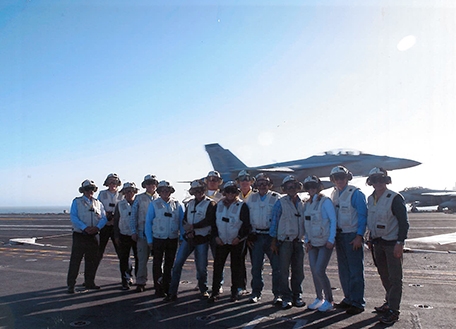
Paul Calleja recently visited the U.S. Navy aircraft carrier John C. Stennis 100 miles off the coast of San Diego to learn about military experience and the opportunities it affords to young people.
More than two years ago, Calleja, who is himself a pilot, read about the chance to take part in a mentorship and community relations initiative called the Distinguished Visitor Embark Program. The program places leaders from all sectors of society — corporate, civic, government, education, nonprofit and service — aboard a deployed carrier. Calleja is a clinical associate professor of kinesiology at the University of Arkansas.
The Navy notified Calleja he had been chosen about two weeks before he flew to San Diego in April. He joined 11 other people, mostly from the business world but one other faculty member, who was from the University of California at Berkeley.
"It was an opportunity for me to understand how 5,500 people on a boat operate together," he said. "It's massive, the size of a small city."
Participants on the overnight visit met with people who worked in all areas of the ship, including ordnance, food service and deck operations.
"We learned what they do and the role of the military in training young people from about 18 to 25," Calleja said. "The experience just illustrated other pathways that young people take out of high school and college. I took away a better understanding of what the military does. The officers represent a smaller percentage of personnel, but students coming through the University of Arkansas can join the Navy and become officers. They hold different types of positions on the carrier, including working as pilots and other leadership roles."
Calleja's group landed on the carrier with the use of an arresting hook on the plane that stops it quickly when wires on the carrier catch the hook.
"I have a pilot's license and usually you have lots of runway to slow down," he said. "The aircraft carrier is the length of four football fields, so it's a very short space to land and take off. Instead of gliding in, the plane slams into the deck, the hook catches and dissipates energy. It knocks the wind out of you. As the plane comes to a halt, you experience quite a few G's."
G's refers to gravitational force, or g-force, a measurement of acceleration.
Takeoff from an aircraft carrier is accomplished with a catapault launch, Calleja said, and the participants also experienced that.
"The catapault device is hooked to the nose of the plane and it makes the plane go from 0 to 150 mph in a few seconds," he said. "It lets go and the plane flies."
Contacts
Heidi S. Wells, director of communications
College of Education and Health Professions
479-575-3138, heidisw@uark.edu